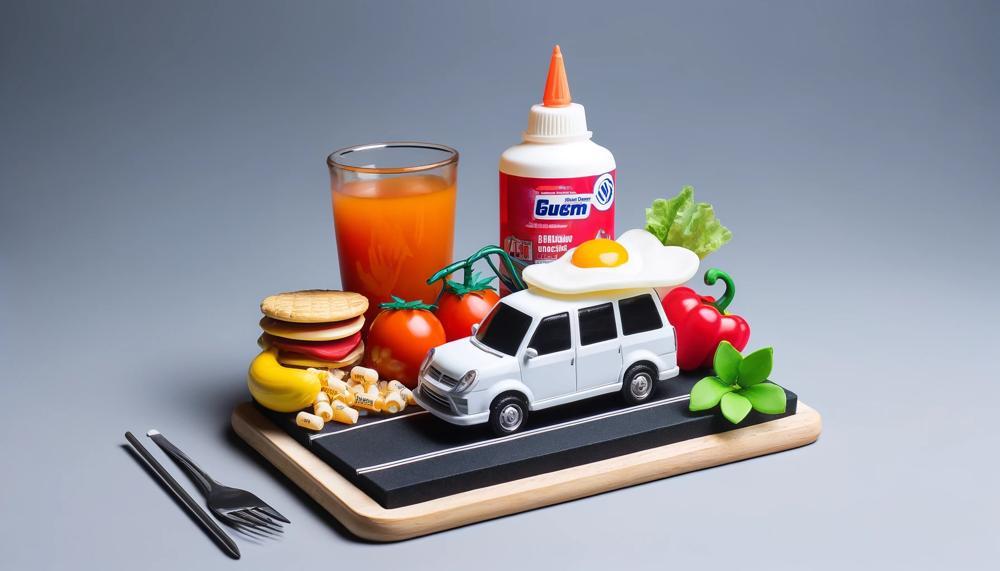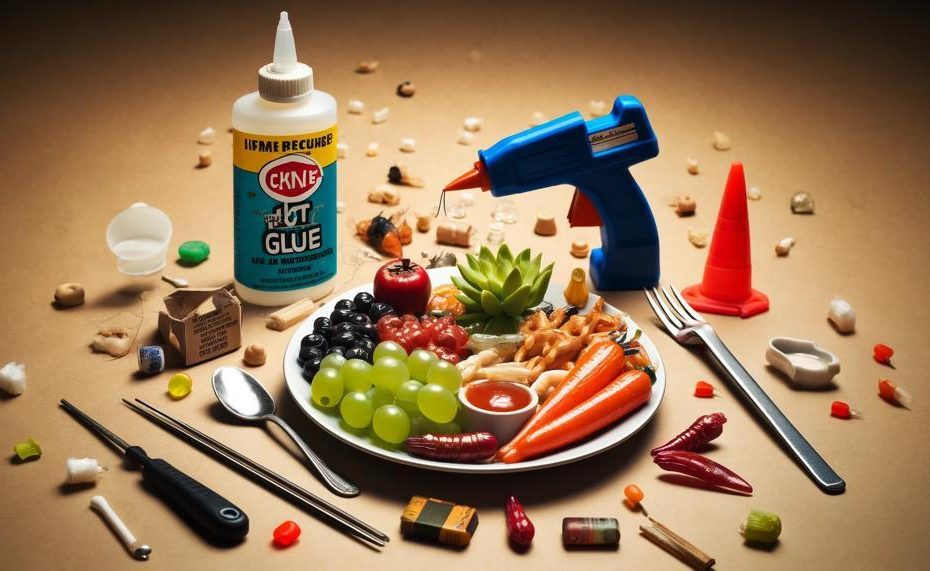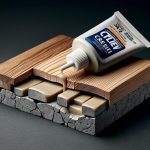Did you know that even though hot glue guns are great for making, you need to be careful when using them for food projects? This useful tool is known for being able to bond things quickly, but it can be dangerous if used incorrectly near food or other products.
Usually, hot glue isn’t safe for food. If you don’t use it carefully, the chemicals in the glue could get into the food and cause health problems.
Here’s what you need to understand about the relationship between hot glue and food safety:
Yes, hot glue can be used near food, but it requires careful consideration. Chemical migration can occur when the high temperatures of melted hot glue cause certain chemicals to leach out, potentially contaminating food items.
To ensure safety, it is imperative to use food-grade hot glue specifically crafted for this purpose. These glues are composed of ingredients rigorously tested and approved for contact with food1. If you absolutely must use hot glue near food, make sure it is fully cured and cooled before it comes into contact with any food. This helps minimize the risk of any residual chemicals transferring onto your delicious creations.
However, most glue sticks for hot glue guns are completely food safe and are readily available. To be 100% sure, you should always check the manufacturer’s description of the ingredients inside the glue sticks.
If in doubt, opt for alternative adhesives explicitly labeled as safe for use with food1. For example, Cyanoacrylate Glue (CA Glue) is typically used in the medical industry, is safe for skin contact and briefly for food contact. It should not be used for long-term food contact or in applications that involve heat, as it can break down.
These points outline the crucial considerations you must keep in mind to maintain safety and creativity in your food-related projects. Let’s dive deeper into each aspect to ensure that your next craft session is both fun and safe.
Table of Contents
What is Hot Glue?
Hot glue, also known as hot melt adhesive, is a type of thermoplastic adhesive. It is notably different from other adhesives because it melts and flows when heated and quickly solidifies into a strong bond upon cooling.
This process is distinctly different from other glues that typically cure through evaporation or chemical reactions. Below is a detailed comparison using various parameters:
| Parameter | Hot Glue | Other Types of Glue |
| Composition | Thermoplastic compounds | Range from natural substances like casein to synthetic resins |
| Curing Mechanism | Cures by cooling down | Cures by evaporation, chemical reaction, or moisture |
| Application Process | Melted via a glue gun and applied hot | Applied at room temperature or requires mixing of components |
| Strength | Lesser structural strength, more for temporary or light-duty bonding | Often stronger and suited for structural applications |
| Reusability | Can be reheated and reused | Generally not reusable, with single application |
| Heat Resistance | Poor resistance to high temperatures | Varies, some like epoxy or silicone have high heat resistance |
Potential Risks of Using Hot Glue Near Food
Using hot glue near food introduces a range of hazards primarily centered around the potential for chemical migration.
As the glue melts at high temperatures, harmful substances may leach into food items, presenting significant health risks if ingested.
Dangers and Prevention Methods:

| Danger | Consequence | Prevention Method |
|---|---|---|
| Chemical Migration | Transfer of harmful chemicals into food, which can pose health risks when consumed. | Utilise food-safe hot glue sticks designed specifically for culinary applications. |
| Direct Contact with Food | Accidental adherence of non-food-safe materials to edibles, potentially introducing toxins. | Avoid direct contact between hot glue and any food items by using barriers such as parchment paper. |
| Contamination from Equipment | Glue guns accumulating food particles or other contaminants, further risking food safety. | Regularly clean glue guns and keep them separate from kitchen tools to prevent cross-contamination. |
For enhanced safety, consider alternatives to hot glue when working near food. Food-grade silicone adhesive or edible materials like icing are safer choices, as they do not pose the same chemical risks and are designed for contact with food.
Chemical Migration and Contamination Concerns
The use of hot glue near food can significantly heighten the risk of chemical migration and contamination. Here’s a precise breakdown of this concern:
- Temperature Concerns: The primary risk arises from the high temperatures at which hot glue melts. These temperatures can cause harmful substances within the glue to leach out. When hot glue is applied near or on food containers, there is a potential for these chemicals to migrate into the food.
- Composition of Hot Glue: Standard hot glue sticks are composed of materials that are not approved for contact with food. These include various polymers and additives designed to enhance the glue’s properties, which can be toxic if ingested.
- Direct Contact and Health Risks: If food comes into direct contact with hot glue, there is a risk of ingesting not just the chemicals, but also small particles of the glue itself. Such incidents pose immediate health risks and, in environments like professional kitchens, could also lead to legal repercussions due to non-compliance with health regulations.
- Avoid Direct Contact: Ensure that the glue does not touch any part of the food directly. Use barriers if necessary.
- Choose the Right Glue: Opt for food-grade hot glue when the presence of food is unavoidable.
- Monitor Temperature: Be cautious of the temperature at which you operate the glue gun to prevent excessive heating.
- Plasticizers: These are used to make the glue more flexible. Common plasticizers in hot glue include phthalates, which can leach into food, potentially disrupting hormonal balance.
- Antioxidants: Added to prevent oxidation and degradation of the glue, some antioxidants can be volatile at high temperatures and might contaminate food surfaces.
- Stabilizers: These help maintain the consistency of the glue but may contain heavy metals like lead and cadmium, which are toxic if ingested.
- Colorants: To make the glue visually detectable, colorants are added. These dyes can sometimes be toxic if they come into direct contact with food.
- Tackifiers: These increase the stickiness of the glue. Some tackifiers are based on rosin, which can be safe, but synthetic options might release harmful vapors when heated.
- Food-Safe Hot Glue Sticks: Opt for hot glue sticks that are specifically labeled as food-safe or FDA-approved. These are formulated to be non-toxic and safe for incidental contact with food.
- Protective Barriers: Employ a protective layer such as parchment paper or wax paper between the hot glue and the food. This prevents the glue from directly contacting food items and allows for easy cleanup.
- Temperature Consideration: Be cautious with items that will encounter high temperatures. Hot glue can melt again when reheated, so it’s best to avoid using it near foods that will be heated or cooked.
- Alternative Adhesives: Consider using other types of adhesives that are safe for use around food:
- Food-Grade Silicone Adhesive: Offers a flexible, waterproof, and heat-resistant bond.
- Double-Sided Tape: A quick and easy option for light bonding tasks without the mess.
- Stainless Steel Clips or Fasteners: Ideal for reusable, non-adhesive securing of materials.
- Edible Materials: For purely food-related applications, substances like icing or frosting can serve as natural adhesives.
- Hygiene and Safety Practices: Maintain cleanliness in your work area and tools, such as glue guns. Use food-grade silicone mats to catch drips and spills, ensuring that your workspace remains clean and that any accidental contact with food is safe.
To mitigate these risks, it’s crucial to use only food-grade hot glue when working near food. This type of glue is specifically formulated to minimize chemical migration and is generally non-toxic, odorless, and tasteless. Here is a detailed comparison table of standard and food-grade hot glue:
| Type of Glue | Chemical Composition | Temperature Resistance | Safety Features |
| Standard Hot Glue | Polymer blends, potentially toxic additives | High | High risk of contamination |
| Food-Grade Hot Glue | Non-toxic polymers | Medium to High | Lower risk, odorless, tasteless |
Safety Precautions:
Additives in Hot Glue
Hot glue typically contains various additives that enhance its properties but could pose risks when used near food. Here are the primary additives and their potential hazards:
Using hot glue near food can lead to chemical migration, especially at the high temperatures needed to melt the glue. To avoid potential harm, it’s essential to use food-grade hot glue that excludes these hazardous additives. This specialized glue is designed for safe use around food, as it adheres to stricter regulatory standards.
Is Hot Glue Food Safe?
Hot glue is not inherently food safe. The primary concerns stem from the risk of chemical migration. When hot glue is heated, potentially harmful chemicals can leach out, contaminating food with substances not intended for consumption.
Given this, it’s crucial to differentiate between regular hot glue and food-grade hot glue, the latter being specifically formulated to minimize these risks with non-toxic, heat-resistant, and odorless properties suitable for indirect food contact.
To address the potential risks of using hot glue near food and outline preventive measures, consider the detailed table below:
| Risk | Description | Prevention |
| Chemical Migration | High temperatures can cause harmful chemicals from standard hot glue sticks to migrate into food. | Use only food-grade hot glue sticks designed for safe use near food. |
| Direct Contact with Food | Direct contact between hot glue and high-temperature foods increases the risk of contamination. | Avoid direct contact by applying a protective barrier between the glue and the food or using alternative food-safe adhesives. |
| Release of Additives | Additives in non-food-safe hot glue, such as plasticizers and stabilizers, may pose health hazards if ingested. | Select hot glue products that comply with food safety regulations, ensuring they are free of harmful additives. |
In practice, to safely use hot glue in contexts involving food, opt for adhesives that are clearly labeled as food-grade. This ensures they meet stringent safety standards and are less likely to cause harm.
Benefits of Using Food-Grade Hot Glue
Food-grade hot glue provides several distinct benefits that make it an ideal choice for food-related applications, particularly when compared to other types of adhesives. Below is a detailed comparison presented in a table format for clarity.
| Feature | Food-Grade Hot Glue | Other Types of Glue |
|---|---|---|
| Food Safety | Explicitly certified as safe for incidental food contact; carries FDA approval. | May lack necessary certifications; risk of chemical contamination if not food-safe. |
| Temperature Resistance | Can withstand high temperatures, suitable for items that might be heated or cleaned in dishwashers. | Performance varies; some may degrade or leach chemicals when exposed to heat. |
| Bond Strength | Forms a robust bond that is reliable for long-term use in kitchen environments. | Bond strength can be inconsistent and not specifically designed for repetitive kitchen use. |
| Chemical Stability | Designed to resist breaking down or migrating into food, which could pose health risks. | Industrial or non-food-safe glues may release harmful additives into food under certain conditions. |
| Application Specificity | Specially tailored for safe use around food and in kitchen utensils. | Often general-purpose and not optimized for direct or indirect contact with food. |
These advantages highlight why food-grade hot glue is a superior choice for anyone needing a safe and effective adhesive for food-contact or kitchen items.
Its ability to maintain integrity under kitchen conditions, coupled with safety certifications, ensures that it does not compromise the food’s safety and quality.
Alternatives to Hot Glue for Use Near Food
When crafting or creating items that will be in close proximity to food, using conventional hot glue can be unsuitable due to its potential chemical leach and high temperature. Here are some reliable alternatives that ensure both safety and effectiveness:
Choosing the right adhesive method depends significantly on the specific needs of your project, considering factors like temperature exposure, permanence of the bond, and direct food contact.
Tips for Using Hot Glue Near Food Safely
When working with hot glue near food, meticulous care is essential to avoid contamination and ensure a safe crafting experience. Below are the crucial precautions to consider:
Select Food-Safe Glue Sticks
Opt for hot glue sticks that are explicitly marked as FDA-approved for food contact. This ensures the glue is safe for applications near or on food containers and utensils.
Maintain a Clean Glue Gun
Regularly clean your glue gun to prevent old, potentially contaminated glue from coming into contact with new projects.
A clean gun ensures that the hot glue applied is as pure as possible.
Use Protective Barriers
When gluing decorations or labels that might touch food, always use a protective layer like parchment or wax paper between the glue and the food surface.
This barrier prevents direct contact and potential chemical migration into the food.
Avoid Direct Food Contact
Never apply hot glue directly on surfaces that will interact with food, particularly if the food will be consumed hot.
The heat could accelerate chemical leaching from the glue into the food.
Consider Safer Alternatives
Where possible, use alternative adhesives that are designed for culinary use, such as food-grade silicone or edible materials like icing, which naturally adhere without health risks.
Here’s a tabular breakdown of these tips for ease of implementation in a crafting scenario:
| Precaution | Implementation | Reason |
| Select Food-Safe Glue Sticks | Choose sticks labelled as FDA-approved. | Ensures chemical safety when in proximity to food. |
| Maintain a Clean Glue Gun | Clean before each use, removing old glue residues. | Prevents contamination from previous uses. |
| Use Protective Barriers | Apply parchment/wax paper between glue and food surfaces. | Blocks direct contact and chemical transfer to food. |
| Avoid Direct Food Contact | Do not apply glue where it might touch hot food. | Prevents potential leaching of harmful chemicals. |
| Consider Safer Alternatives | Use food-grade silicone or edible adhesives like icing. | Offers a non-toxic alternative for attaching food decorations. |
Conclusion
In considering the safety of using hot glue near food, it’s crucial to recognize that not all hot glues are created equal. While traditional hot glue may introduce risks due to chemical migration, especially at high temperatures, food-safe hot glue presents a viable alternative. These adhesives are designed specifically with food contact in mind, ensuring they meet rigorous standards for non-toxicity and minimal chemical leaching.
The wisdom lies in selecting the right adhesive for your project. For food-related applications, opting for a product explicitly certified for food contact can make all the difference. Such products are engineered to withstand the rigors of kitchen environments without compromising food safety. This includes maintaining stability under varying temperatures and resisting breakdown that could release harmful substances into food.
For those engaging in crafts or repairs in proximity to food, also consider employing barriers like parchment paper to prevent direct contact, and always maintain a clean workspace and tools. Should the situation demand, explore alternatives like food-grade silicone or edible adhesives, which offer peace of mind by being inherently safe for such uses.






